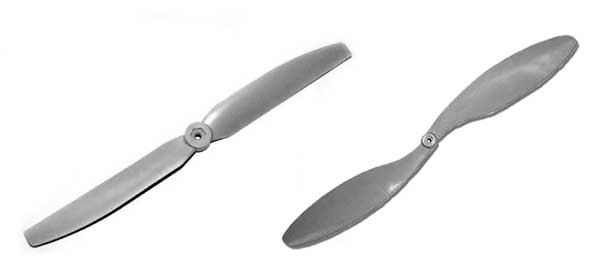The two primary measurements are the prop’s diameter, and its pitch. Diameter is self-explanatory. Pitch is the amount of twist each propeller blade has, and how much air it will scoop up as it turns.
A propeller with a pitch of five inches will, in theory, drill through a column of air five inches deep with every revolution. A propeller with a pitch of zero would be completely flat, and wouldn’t move any air at all.
Propellers are designated by their diameter and pitch. The propeller in the photo is a GWS 8040. It has a diameter of 8 inches, and a pitch of 4 inches. A GWS 7035 has a 7-inch diameter and a 3.5 inch pitch. There are slight differences in the ways various props are designated, but the code is easy to figure out once you know what you’re looking at.
- 6040 – 6″ diameter / 4″ pitch
- 7 x 5 – 7″ diameter / 5″ pitch
- 9047 – 9″ diameter / 4.7″ pitch
The bigger the diameter, the wider the column of air the propeller moves. The bigger the pitch, the deeper the column of air the propeller moves. This leads to our rule of thumb:
- Rule of Thumb: Diameter determines thrust / Pitch determines speed
A wide propeller with a small pitch gives you lots of pull at low speeds but a relatively low top speed. A smaller propeller with a large pitch provides less thrust – less pulling power at low speeds – but a high top speed.
So why not use a wide propeller with a large pitch and get the best of both worlds? Because you’ll cook your engine.
- Rule of Thumb: Increasing a propeller’s diameter increases its amp draw
- Rule of Thumb: Increasing a propeller’s pitch also increases its amp draw
Increasing either the pitch or the diameter of the propeller increases the size of the column of air it moves with every rotation. The more air the propeller is trying to move, the harder the motor (and ESC and battery) are working.
Your plane’s setup will only deliver a certain amount of power efficiently. Put too big a propeller on it and, at best, it’ll be inefficient. At worst, you’ll fry something.
It’s a compromise between speed and thrust. What’s best depends on the plane you’re putting it on.
And then there’s shape. These are both GWS 8″ x 6″ propellers, but they are clearly different:

The propeller on the left is design to rotate at much higher speeds than the propeller on the right. The prop on the right is called a ‘slow fly,’ and is designed for just that: slow flying. These props are usually thinner and floppier; high RPMs can distort and even destroy it.

